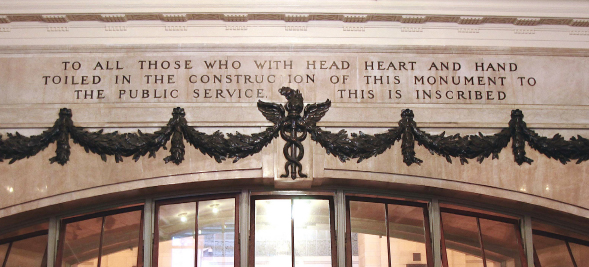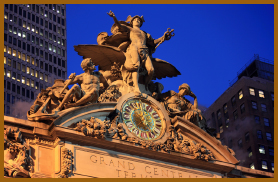

ON WEDNESDAY MORNING, JANUARY 8, 1902—111 years ago—Train 118, the local from White Plains, was late. It was due at Grand Central Station at 8:15 a.m., but, already behind schedule, it was delayed at 110th Street for nearly five minutes to let another southbound local, this one from Croton, pass ahead of it. Incoming delays to Grand Central were nothing new. After all, since the Park Avenue Tunnel was built in 1875, three railroad companies had shared the four-track main line down Manhattan’s spine. By 1902, the three railroads carried 44,000 passengers every weekday, or 16 million a year, on a total of 177,450 trains—one every 45 seconds during rush hours.
At the throttle of Train 118 was 36-year-old John M. Wisker. Even on the best of days, Wisker, the mustachioed son of German immigrants, was not a patient man. Although he had worked for the railroad for seven years, he’d spent most of that time as a locomotive fireman and had been promoted only the previous August to engineer, and even then he mostly filled in for full-timers. As an engineer, he usually piloted milk trains, early in the morning before the road became more congested. That week, he had no intention of piling up a record for tardiness, especially on what amounted to a tryout on a prestigious commuter route. Leaving the apartment he shared with his wife in the Bronx, he would ordinarily get to work while it was still dark, though this week, because he was on call, he slept on a bare wooden bench in the roundhouse in White Plains. That, he explained later, made him even more nervous than usual, coupled with the fact that the locomotive he was driving had a record of faulty air brakes.
On Sunday night, January 5, the regular engineer of Train 118 had called in sick. Wisker was recruited to replace him. On Monday, Wisker piloted a passenger train through the Park Avenue Tunnel for the first time. On Tuesday, Train 118 arrived at Grand Central promptly at 8:15. But on Wednesday, the train was already a minute and a half late when it left White Plains. Wisker was worried about making up lost time in between the seven stations on the 19-minute run. The unlit tunnel reeked of coal gas. It was not only smoky but also foggy that morning. “Unusually murky,” was how one flagman described it. Outside, it was snowing. “It was just the kind of weather that would make smoke or vapor hang in the air a long time without being shattered,” Thomas F. Freel, an acting battalion chief of the city’s fire department, later recalled.
A crew member would testify that No. 118 was proceeding at a robust 20 mph, but a railroad official who was on the train later estimated that it was speeding through the tunnel at up to 35 mph. By this point, the train was five minutes late. Whether Wisker saw the green cautionary light (this was before green meant go), a flare, red lanterns, and other warning signals and simply ignored them was never definitively determined by railroad officials or by a grand jury. He insisted that he did not, nor did he hear the fireman’s cry of “Green,” although according to one version Wisker applied a brake at the last moment. When he saw the red light at 58th Street, where the mouth of the tunnel yawned into a vast open-air train yard two cross-town blocks wide and below street level, it was too late. One news reporter interviewed Wisker before his arrest and wrote, “The only explanation he can give is that he was trying to make up lost time.” Wisker, a news report concluded, “was sober, but he was both ambitious and impatient of delay.”
What is known for sure is that at exactly 8:20, without warning and despite the heroic efforts of a brakeman, Train 118 slammed into the rear car of a Danbury commuter train parked on the same track. The Danbury express was awaiting a signal that yard work had been completed so it could proceed to Grand Central, where it had been due at 8:17. Fifteen passengers, among the 60 who boarded in the last car at the New Rochelle station, were killed instantly. Most were crushed to death by the telescoping engine or scalded in a horrific mass of twisted wreckage, mangled limbs, and sputtering steam that remains Manhattan’s worst railroad accident.
The last bodies were not removed for more than 10 hours. “The hissing steam and smoke made it seem that I was going to be cooked alive,” said Richard H. Mollineux, 23, who fractured his right thigh and was among the 36 passengers injured. Two of these died within a week. Among the dead were Amanda F. Howard, who had been married only six months and worked at Standard Oil; Theodore Fajardo, a Spanish-born buyer for a Cuban importing firm, who left a widow and four young children; and Oscar Meyrowitz, general manager of E.B. Meyrowitz Opticians, established by his brother, Emil. “As slowly the harvest of death reaped in the hole under the New York streets is being garnered in the homes of New Rochelle,” the New York Times reported, “the townsmen of the dead and the maimed are beginning to ask each other not how this thing occurred, but why.”
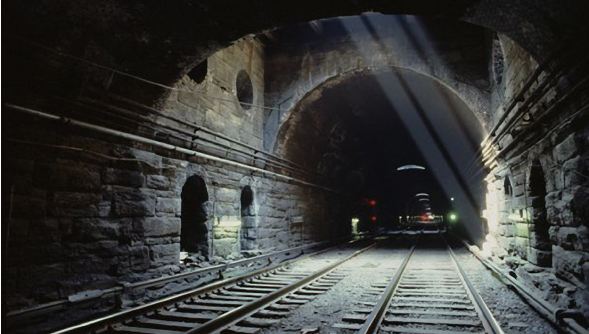
IMAGINE NAVIGATING THE PARK AVENUE TUNNEL WHEN IT WAS CHOKED WITH SMOKE AND SOOT FROM STEAM LOCOMOTIVES.
J.H. Franklin, the manager of Grand Central, singled out John Wisker for blame. But the Reverend J.E. Lovejoy of the Mott Avenue Methodist Episcopal Church, in his sermon the following Sunday, defended Wisker, his devout parishioner, and pointed fingers elsewhere. “It is easy to convict a poor man of almost any crime, but it is almost impossible to prosecute the rich man, who with haughty insolence jingles his dollars in his pockets and pulls powerful influences his way.” A coroner’s inquest lodged no formal charges, but a special state commission delivered a stinging rebuke to the railroad for gross negligence “in putting an engineer of such limited experience and unascertained capacity” at the controls of a passenger train at rush hour. No railroad officials were charged, however. Wisker was indicted for second-degree manslaughter because he “unmistakably violated the well-known rule which, under the conditions surrounding him, required him to stop his train.”
THE CRASH OCCURRED AT 56TH STREET, not far from the Vanderbilt mansion on Fifth Avenue. Cornelius Vanderbilt III and Alfred Vanderbilt, great-grandsons of the Commodore, rushed to the scene in time to learn that Wisker had been arrested by the New York City police pending a coroner’s inquest. Almost on the spot, they joined other railroad officials, including William J. Wilgus, the New York Central’s chief engineer, in a decision that would change the face of New York. Given the state railway commission’s subsequent findings, the grand jury’s decision not to prosecute the railroad’s chief executives this time was simply too close for comfort. “It was not enough that the New York Central Railroad had been maintaining for many years a defective signal system and that any day a serious accident might happen as a result of the maintenance of such a system,” said William Travers Jerome, the district attorney (he was a nephew of Leonard Jerome, who had been Cornelius Vanderbilt’s stockbroker), “but it must have been found affirmatively, and beyond reasonable doubt, that this particular accident, with the ensuing deaths, occurred as the direct result of its defective system.” The next time, a grand jury might do just that.
Even with the recent renovations, Grand Central Station, which was already outmoded the day it opened a generation earlier, would have to be razed. The rails would have to be electrified. The goat pastures and shanties that still dotted mid-Manhattan would be replaced by a colossal Grand Central Terminal. It would be a majestic gateway to the nation’s greatest city, the catalyst for a new Midtown flanking a breathtakingly luxuriant boulevard, and a prototype for innovative transportation and urban planning imperatives across the country.
In short, the new Grand Central Terminal was built, in a way, by accident.
TERMINAL CONNOTES AN ENDING. For a century, Grand Central has been anything but. This book is Grand Central’s biography. Nobody who has been there, no one who has witnessed the intricate choreography on the Main Concourse or eavesdropped on the crowd’s collective voice, could doubt that a building, a supposedly quiescent pile of marble and stone, could embody a living organism. The terminal is the throbbing heart of a city. “As the earth cooled,” Colson Whitehead wrote in The Colossus of New York, “Grand Central bubbled up through miles of magma, lodged in the crust of this island, settled here. The first immigrant. Still unassimilated. Ever indigestible. The river of skyscrapers flows around it. Travelers swim to it and cling, savoring solid handhold in roaring whitewater. Churches full up at regular intervals on a schedule laid out in the business plan. Like the best storms, rush hour starts out as a slight drizzle, then becomes unholy deluge.”
The story of Grand Central mirrors the story of urban America.
It is a story that reveals the secrets of hidden staircases, mysterious underground vaults, a publicity-shy owner, and a secluded platform reserved for the president of the United States. It is a story about people, from Bryan Henry, a Metro-North cop who befriended the homeless, to Audrey Johnson, who fields customers’ questions in the information booth, to Jacqueline Onassis, whose devotion to historic preservation saved the terminal from certain destruction.
Grand Central has been the wellspring of new beginnings for millions of people who arrived in New York to fulfill their dreams, heeded the siren call to go west, and returned lovesick to their hometowns. Unlike a station, a terminal conjures up a destination, not merely a place to pass through. Grand Central embodied that role, as the gateway to New York since 1913 and as the city’s Gateway to a Continent. Between 1913 and the centennial of the New York Central in 1926, the number of passengers served annually by the terminal nearly doubled, to 43 million from 23 million. Today, the number is verging on a record, headed, for the first time, toward the 100 million passengers a year forecast when the terminal first opened a century ago.
ITS ROLE IN THE PEOPLING OF AMERICA would be reason enough to celebrate Grand Central’s centennial and to mine its cavernous halls and subterranean lairs for historical lore. But there’s more. The terminal has been the site of ransom demands and mail train robberies, of triumphal homecomings and hope-filled send-offs, the target of Nazi saboteurs and terrorist bombs. Its passengers have included presidents, living and dead, and foreign potentates. People have been born and have married and died there. Funeral corteges have carried statesmen and war heroes home from and to there. Kids left for summer camp and soldiers went to war. A steer once escaped from an East Side slaughterhouse and infiltrated the train yards. Four elephants, weighing 22 tons combined, wended their way through the waiting room in 1921 to board their sleeping car on Track 37 for the trip to Boston, where they were due for a matinee performance the next day.
The terminal houses six secret staircases. One goes to a top floor that officially doesn’t exist but played a pivotal role on 9/11. Another leads to a secret subbasement, which was excised from the building’s floor plans and would be constructed to convert AC to DC power and where one red button can shut down the railroad. A third accesses a secret train platform still protected by armed guards.
Time as we now know it originated in Grand Central. The 13-foot-diameter clock facing 42nd Street is described as the world’s largest example of Tiffany glass, and the limestone sculptures of Minerva, Hercules, and Mercury were considered the largest sculptural grouping in the world. The Grand Central building would house CBS television studios where Edward R. Murrow would broadcast and What’s My Line and The Goldbergs would originate. The Park Lane, an apartment hotel, would become home to Rudolph Valentino and Frederick T. Ley, who built the Chrysler Building. The 20th Century Limited and the Wolverine were among the storied trains that arrived and departed from the busiest train station in the country to and from points west. In 1947, 65 million passengers traveled the rails from Grand Central. In 2011, Metro-North became the nation’s busiest commuter railroad. Its annual ridership surpassed 82 million. And Grand Central is the world’s largest rail terminal, with 43 platforms fed by 43 tracks, plus another 48 underground storage tracks. It is about to grow even bigger with a Long Island Rail Road connection and separate station.

THE PARK AVENUE VIADUCT, LOOKING NORTH TOWARD THE 60-FOOT-HIGH ARCHED WINDOWS THAT FORMED WHITNEY WARREN’S TRIUMPHAL GATES.
The terminal has threaded itself into popular culture. Mad Men’s Roger Sterling gorged himself on oysters and martinis there. Cary Grant called his mother from a phone booth before fleeing town on the 20th Century Limited in North by Northwest. An art student finds a cache of diamonds there in James Patterson and Marshall Karp’s Kill Me If You Can. Philippe Petit performed his tightrope walk under the terminal’s celestial ceiling. Holiday magazine recalled the exploits of a newly married couple whose train to Niagara Falls was canceled; they honeymooned at Grand Central instead: “They got a room at the Biltmore Hotel, linked to the terminal by an underground corridor, dined, danced, took advantage of the terminal’s shops and exhibition halls—and did all this without ever once seeing a train. Later, terminal officials heard the couple were planning to repeat the idea as an anniversary celebration.”
“JUST WALKING THROUGH the vast main concourse of Grand Central Terminal—something that over half a million people do every working day—almost always triggers in me a spontaneous and quiet change in perception,” Tony Hiss wrote in The Experience of Place. “I feel relaxed and alert at the same time.” Some are mesmerized by the sound of hundreds of people simultaneously walking and talking in 11 million cubic feet of air. “This sound, pleasant in all its parts, regular in all its rhythms and humorous and good-natured, seemed also to have buttoned me into some small, silent bubble of space,” Hiss wrote. “I felt that I wasn’t quite walking but was paddling—or somehow propelling—this bubble across the floor.”
Other people dream about Grand Central. Ami Ronnberg of the C.G. Jung Center in Manhattan was quoted as saying she had done so herself, and called the terminal a powerful symbol. “Just think of the name,” she said. “It’s the central place, where all things connect. It’s underground, it’s below what we know about and it’s what we know about.” Grand Central itself became the nexus of Mad Men’s second season promotional campaign because, Linda Schupack, the marketing chief at AMC, explained: “It works on multiple levels. It is, of course, so iconic to New York, but it’s also a place of transition.” Constantin Brancusi, the modernist sculptor, pronounced the terminal “one of the most beautiful specimens of modern architecture”—specimens so beautiful, he said, that they “give me as much pleasure as if I had done them myself.” Henry-Russell Hitchcock, the architectural historian, dubbed it “one of the grandest spaces the early 20th century ever enclosed.” Grand Central’s survival spawned a preservation movement that spared other historic places all over America. The architecture critic Paul Goldberger proclaimed it “the poster building for every landmark in the United States.”
EVERY INDIVIDUAL EXPERIENCES GRAND CENTRAL in a different way. Ben Cheever’s Proustian memory is of his chaffed thighs, but he also marveled how even a small boy was not overwhelmed by the vast Main Concourse. “The counters are at the exact right height to lean or write on, the balustrades are for sitting, the dimensions of the marble slabs match those of the human body,” Cheever wrote. “The building, like the body, is wonderful in its symmetry.” Cheever, whose father was exalted as the “Chekhov of the Suburbs,” called the terminal as inviting as “a rich person’s house with the doors thrown wide. The concourse is larger than the nave of Notre Dame Cathedral and yet is strangely inviting; awesome, but in no way awful,” he wrote. “Even as a child, on my dismal way to Brooks Brothers to be fitted for a flannel suit that would chafe the skin off my thighs, I did not feel diminished.”
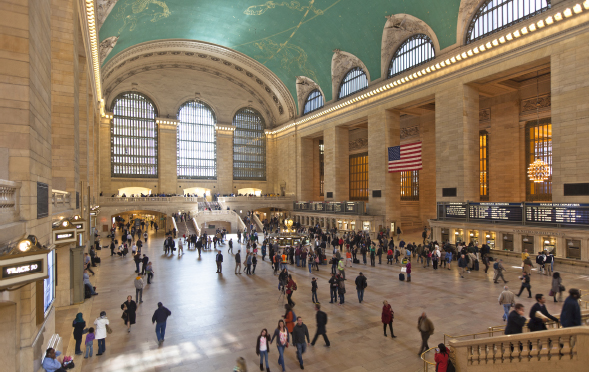
THE GLORIOUSLY REFURBISHED MAIN CONCOURSE STRIPPED BY THE MTA OF CRASS COMMERCIALISM AND GAUDY SIGNAGE.
“The concourse is not just any room; it’s my room,” he wrote. “This half-acre of Tennessee marble is the stage on which I have many times appeared. ‘Stand up straight. Take that paw out of your mouth’ my father used to say, dragging my tiny, be-suited person across the echoing expanse. ‘Admire the stars in the ceiling.’ So I craned my little neck.”
My own best memory is also of a visit to Grand Central with my father in the 1950s. I was standing with him on a platform, staring wide-eyed at a giant locomotive, when the engineer invited me into the cab. I even remember the locomotive’s number: New York Central 371. As I remember it, he placed my hand on the throttle and the engine chugged forward a few feet. To me, it seemed like a mile.
OKAY, BE A STICKLER: Grand Central is not a station; it’s a terminal. Trains terminate there. Railroad people like to recall the apocryphal rube who asked a conductor whether his New York Central train stopped at New York City. To which the conductor replied, “There’d be an awful crash if it didn’t.” The point is, David Marshall wrote in Grand Central in 1946, you couldn’t tell that story about Pennsylvania Station, which, for all its splendor, one wag lamented, reduced New York “to a two-minute stop on the line from Long Island City to Rahway, New Jersey.”
Two Grand Central Stations do exist in New York City—the post office on Lexington Avenue and the Interborough Rapid Transit subway stop that serves the Nos. 4, 5, 6, and 7 and the Times Square shuttle. There once was a railroad depot called Grand Central Station on 42nd Street in Manhattan, but it was razed a century ago to make room for this one. The dictionary says a terminal can be a station, but not every station is a terminal. “To 80 or 90 percent of the people of New York it’s Grand Central Station,” David Marshall wrote. “And so I have called it in this book—on the principle of Securus Judicat orbis terrarum” (or, as Augustine of Hippo would have said had he spoken English, “the verdict of the world is conclusive”).
NEARLY 3 MILLION CUBIC YARDS of earth and rock would be excavated for the tracks, and construction would take 10 years and cost more than $2 billion in today’s dollars. Atop the terminal’s 48 acres sits some of the richest real estate and the most prestigious addresses in the world. Its construction established the legal principle of air rights, which created an ephemeral commodity worth billions of dollars. The threat of its demolition affirmed another legal principle: government precedence over private property to preserve a historic landmark. “Viewed urbanistically,” architectural historians wrote in 1990, “Grand Central Terminal is without parallel.” Their report continued:
The urban design of the vast building vitalized and embraced its broader surroundings. Accommodating the city, the Terminal provided a circumferential roadway which circled it, underground passages which linked to buildings beyond it, corridors and ramps which led one through it, and tunnels for trains and subways to stop beneath it.
The interior comfort and dignity of the traveler and commuter was of paramount consideration in the design of Grand Central Terminal. The elegant finishes and spatial quality throughout created a unified setting with a restful palette of neutral colors. The stark elegance of the uncluttered marble and stone walls and simple black-letter signs, the clarity of the programming and spaces, and the efficiency of the many services and amenities all serve the architect’s original intent that the building “is not to be an art museum, or a hall of fame, but a place of dignified simplicity, easy of access and comfortable.”
Grand Central Terminal was the consummate civic monument—and yet it was even more. Commercially it stood as one of America’s first multi-use buildings, incorporating shops, restaurants, stores and offices—in short, all the diversity of a city within the confines of one building.
In 1967, Grand Central was designated as a New York City landmark. A decade later, modernization of the old Commodore Hotel, the first project in Midtown by Donald Trump, ignited a revival of 42nd Street. And 30 years later, a major renovation restored the station as an architectural gem and a destination not merely for train travelers, but also for shoppers, restaurant-goers, and other visitors. Grand Central anchored the revival of Midtown Manhattan, a revival that would spread west to Bryant Park, behind the New York Public Library, and Times Square and become emblematic of urban renewal at its best. Just recently, the Lincoln Building, originally named for the former president, was rechristened One Grand Central Place, in affirmation of the terminal’s cachet and the city’s resurgence.
THIS BOOK IS MORE THAN A STORY ABOUT TRANSPORTATION. It’s about the expansion of the city of New York into a metropolis and the aggregation of metropolitan government, which mirrored the ruthless consolidation of corporate America and of the nation’s railroads. The terminal was a product of local politics, bold architecture, brutal flexing of corporate muscle, and visionary engineering. No other building embodies New York’s ascent as vividly as Grand Central. And no other epitomizes the partnership that melded the best instincts of government with public-spirited private investment, a model that is being mirrored all over America.
“It is a magical place with a history that captures the city’s early growth, post-1970 crisis and subsequent rebirth,” said Edward P. Glaeser, the Harvard economics professor and author of Triumph of the City. “I remember it as a place of danger and chaos in the 1970s, but thanks to its clever and effective public-private partnership it is a shining center once more. It is worth noting that the success of this partnership hinged in part on New York’s abundance of generous, wildly successful people and that abundance is not available everywhere else in the country—think of the sorry state of Detroit’s Michigan Central Station.”
In listing the terminal on the National Register of Historic Places, the National Park Service suggested that even gateway was not magisterial enough for what Grand Central conjured up. Gateway, the architectural historians James M. Fitch and Diana Waite wrote, “is a totally inadequate term, suggesting a passive orifice under the open sky whereas the terminal must be seen as a mechanism, a great reciprocating engine for pumping a huge flow of pedestrian traffic through a whole series of valves and conduits into connecting systems—trains, subways, taxis, trolleys and elevated trains.”
Despite the early segregation of immigrants and other undesirables underground and later efforts to discourage the homeless, Grand Central has been an egalitarian gateway. “When I first saw Grand Central Terminal close to 40 years ago—headed upstate with my mother and brother to visit Aunt Lillian—it was the quintessential public building, an astoundingly democratic place,” Lee Stringer, the author of Grand Central Winter: Stories from the Street, wrote in 1998.
The porters, Red Caps and conductors all treated us like first-class passengers, though we were traveling the equivalent of steerage. Twenty-odd years later, penniless, I ended up living in Grand Central, along with hundreds of homeless New Yorkers. It has since struck me how perfectly right it was that a great public building should serve, above everything else, as a refuge—in my case for 10 years. Grand Central was anything but beautiful or elegant the winter I first staked out a niche on its lower levels—and certainly not grand. But in the thousand small acts of kindness tendered then by busy, bustling New Yorkers—acts as small as an encouraging word—I detected a whisper of the indomitable spirit that distinguishes this from any other mere compilation of brick and mortar that dares call itself a city. That New York, no matter what the human condition, shrugged and said: “It’s cold. Come inside.”
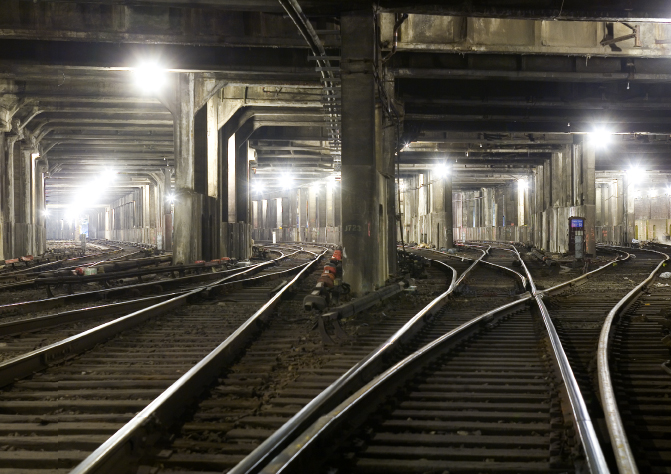
AN ENGINEER’S PERSPECTIVE ON THE LABYRINTHINE “LADDER” OF RAILS, WHICH MERGES INTO FOUR MAIN TRACKS.
No character like Brian Selznick’s Hugo ever lived at the terminal, as far as we know (Selznick visited there, though, for inspiration). Still, Grand Central is a story about people, the people who built it, the people who are employed there and make the place work, and the people who arrive and depart there every day or come for an occasional visit. If the terminal reaches its target 100 million passengers in 2013, that number, combined with the estimated 21 million out-of-town tourists (Travel + Leisure magazine ranked it sixth not long ago in the list of world’s most visited attractions, right after Niagara Falls, and ahead of the Statue of Liberty and the Metropolitan Museum of Art) and the more than 40 million who traverse the Grand Central subway station, would mean that in any given year, the equivalent of half the entire population of the United States passes through.
FOR ALL ITS GLORY, Paul Goldberger wrote in the New Yorker when the terminal was rededicated,
The real brilliance of the place—for all its architectural glory—is the way in which it confirms the virtues of the urban ensemble. Grand Central was conceived as the monumental center of a single composition, with hotels and streets and towers and subways arrayed around it. When it opened, in 1913, it was New York’s clearest embodiment of the essential urban idea—that different kinds of buildings work together to make a whole that is far greater than any of its parts. If Penn Station was built mainly to send a message about the splendor of arrival, then Grand Central was conceived to make clear the choreography of connection.
Every day, that choreography is performed on a gargantuan dance floor called the Main Concourse. “Are the people at Grand Central different?” Alastair Macaulay, the Times’ dance critic, asked.
I cannot prove that the elegance of the place rubs off on people’s behavior, but I sense that these same visitors would not carry themselves in quite the same way at Penn Station or the Port Authority. The immensity of the hall’s space makes an impact at all times, surrounding people with drama. It keeps reminding me of a story my mother used to tell about the days when she worked as an au pair in France. Her employer had a maid from Milan to whom the employer once said politely, “I understand the cathedral in Milan is very beautiful.” The maid replied: “Oh, but Madame! You should see the railway station!”
